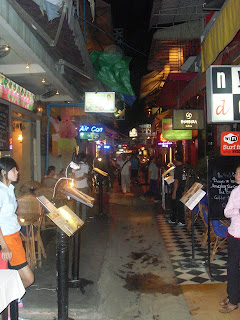On the death of King Ramkhamhaeng in 1298, the first capital of Siam, Sukhothai, went into decline. In 1350, the city of Ayutthaya was started, on a small island of the Chao Phraya River. A year later the Kingdom of Siam was founded under the rule of U-Thong or King Ramathibodi I. The first photo below shows the Chao Phraya today, on it's journey to Bangkok, about 70 km downstream.
Ayutthaya became a great city, and was the capital of Thailand for 417 years. During this time, the kingdom extended across Thailand and modern day Laos, Cambodia and Burma.
The city contains some spectacular ruins that give you a sense of what an amazing city it must have been in its heyday.
The photos below show Wat Ratchaburana


The city is a good day trip from Bangkok, although on this particular occasion it was one of the hottest days in an otherwise unseasonably cool April.
This Wat was built in 1424 and it has undergone a lot of restoration. The large towers are a combination of the Khmer style prang (shaped like a corn cob) that you see in Angkor and Sukhothai style chedi (bell shaped).

Opposite Wat Ratchaburana is Wat Phra Mahathat.
The small size of the island makes it easy to get around, either on foot or by Tuk Tuk or maybe in true Thai style - on the back of an elephant.
More history and photos next time....



























































